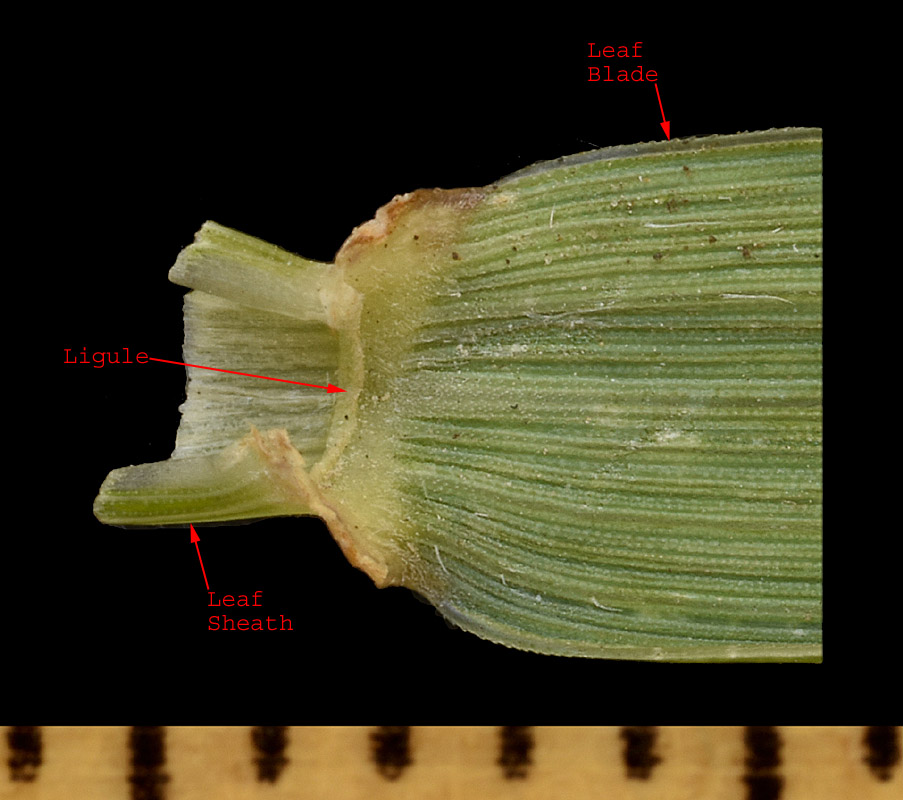 | Triticeae: Answers to key questions
leading to this tribe.
 | Mature inflorescence, if breaking into units, then the units not as
below; NOT [Mature inflorescence breaking into spikelet units consisting
of a sessile fertile spikelet, a hairy pedicel with or without a sterile
spikelet at tip, and a hairy rachis joint, all arising at the same point
(a node) in specialized panicle branches called rames] |
 | Spikelets not as below; sterile florets if present, either located
distal to the fertile floret(s) on the rachilla or paired and attached
at the base of a single fertile floret, not paired with the upper glume
as below; lemma and palea variously textured, enclosing the flower or
not; disarticulation usually above the glumes; NOT [Spikelets usually
dorsally compressed, appearing 1-flowered but containing 1 fertile
floret and 1 sterile floret, the latter attached to the base of fertile
floret opposite the upper glume, resembling the upper glume, and
together with the upper glume enveloping the fertile floret; lower
glumes minute (sometimes absent) to 3/4 as long as upper glumes and
typically wrapping most of the way around the pedicel at base; fertile
floret seed-like with chartaceous-indurate lemma and palea enclosing
flower and fruit; disarticulation below the glumes with rare exceptions] |
 | Spikelets 1 to many-flowered, subtended by a pair of glumes (only 1 on
lateral spikelets in Lolium); palea margins enclosed or not; plants of
dry or wet habitats; NOT [Spikelets 1-flowered, lacking glumes; margins
of the palea tightly enclosed by the lemma margins on female or perfect
florets; plants of wetlands, often emergent aquatic] |
 | Inflorescence a terminal spike with sessile or subsessile spikelets
attached broadside at nodes on opposite sides of the rachis; NOT
[Inflorescence not as above; if a terminal spike, then the lateral
spikelets attached edgewise to the rachis with inner (upper) glume
wanting (as in Lolium)]
|
|
 | Elymus: Answers to key questions
leading to this genus. Not all the answers apply to all members of Elymus,
but they all do apply to a subset containing E. repens).
 | Spikelets 1 per node, occasionally 2 at some nodes; NOT [Spikelets 2 or more per node, occasionally 1 at some
nodes] |
 | Spikes not pectinate with spikelets not arranged as below; spikelets
usually appressed to ascending, sometimes somewhat divergent; glumes
usually flat at base, sometimes keeled towards tip; NOT [Spikes usually
pectinate with spikelets closely-set, regularly-spaced and parallel like
the teeth of a comb; spikelets divergent at angles of 30° to 90° from
the rachis at maturity; glume keels prominent to base] |
 | Introduced or native perennials;
NOT [Introduced annuals rarely found outside cultivation or
plantings] |
 | Glumes and lemmas not particularly thick-textured and rigid, the
apices acute, acuminate or awned; plants native or introduced, uncommon
to very common in SK; NOT [Glumes and lemmas distinctly thick-textured,
rigid and usually blunt- tipped (glumes sometimes mucronate, lemmas
occasionally awned); plants introduced, rare in SK] |
 | Lemmas unawned or with awns straight or somewhat flexuous; if awns
strongly outcurving, then at midspike the spikelets twice as long as the
rachis internodes or longer and extending beyond 2 nodes, and the lemmas
usually pubescent; NOT [Lemma awns strongly outcurving; at midspike the
spikelets the same length as the rachis internodes or 1.5 times as long
and extending into the middle of the next internode; lemmas glabrous] |
 | Plants without the below combination of characteristics: if the glumes
as below then the leaf blade surfaces not markedly different; NOT
[Glumes widest at or near base, not widening at midlength or beyond; the
longer glume about as long as the lowest lemma; leaf blades to 4.5 mm
wide, stiff, usually glaucous, tapering to a sharp point, usually angled
away from the culm at a ± fixed angle approaching 45°; the prominently
ridged adaxial surface markedly different from the ± smooth abaxial
surface; plants with creeping rhizomes]
|
 | Repens: Answers to key questions
leading to this species.
 | Spikelets 1 per node (occasionally 2 at some nodes); glumes lanceolate
or wider (except E. glaucus which may have linear-lanceolate glumes);
NOT [Spikelets 2 or more per node (occasionally 1 at some nodes); glumes
setaceous to linear-lanceolate] |
 | Lemmas usually glabrous; the lower glume usually 3/4 as long to longer
than the adjacent lemma; glumes flat or distinctly keeled distally;
lemma awns, if > 2 mm long, then straight or somewhat flexuous at
maturity; leaf blades seldom involute, usually flat, 2-17 mm wide; culms
growing in tufts without rhizomes (or with very short rhizomes) or
singly from long, thick, creeping rhizomes; NOT [Lemmas usually
pubescent; the lower (shorter) glume usually 1/2 to 2/3 as long as the
adjacent lemma; glumes flat or weakly keeled; lemma awns, if > 2mm
long, then usually curved outward at maturity; leaf blades involute,
seldom flat, 1 — 6 mm wide; culms growing in loose tufts from slender,
creeping rhizomes] |
 | Plants with long, creeping rhizomes; glumes distinctly keeled distally
(at least some glumes in spike), the keel usually extending into either
a smooth, blunt or a scabrous, tapered awn to 3 mm long; lemma unawned
or with awns to 4 (10) mm long; anthers (3) 4-7 mm long; auricles
well-developed; collars on lower leaves divided, often puberulent; NOT
[Plants tufted with dense fibrous roots, rhizomes absent or very short;
glumes flat distally or occasionally weakly keeled, the tips unawned or
tapering into slender, scabrous awns to 11 mm long; lemma unawned or
with awns to 40 mm long; anthers 1.5-3.5 mm long; auricles present,
absent or rudimentary; collars divided or continuous, glabrous] |
|
|

